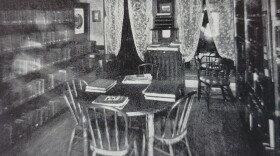Built to specifications sent by Thunder Lakes superintendent George Smith for the purpose of working as a woods switch engine and log hauler in the deep forests of the Northwoods. The 41-ton, 3 foot narrow gauge 2-8-0 locomotive was the only new engine ever purchased by the company, the #5, as it was named in official records, and dubbed the “5 Spot” by it’s crew, was put to work hauling loads of logs immediately upon arriving from Pennsylvania.
After several years of working northeast of Rhinelander; one of the 5 Spots fellow engines, the older #7 engine was retired and donated to the newly built Rhinelander Logging Museum, which was situated on a triangular lot on Davenport St., tucked between the Wisconsin River and the Rhinelander paper mill. As the #5 continued working for the Thunder Lake Lumber Company, the #7 became a playground for two decades of Rhinelander’s resident and visiting children. When the logging museum moved to Pioneer Park in the mid-fifties, so too did the #7 locomotive. The 5 Spot remained working for the lumber company until it pulled it’s rails in 1941. At that time, the #5 was sold to a mining firm with operations in the mountains near Chihuahua, Mexico. Once again, the little engine was sent across the country and began a new career of ore hauling.
For the years the 5 Spot was rolling along under the hot Mexican sun, the #7 stayed on display in the oft sub-zero climate of Rhinelander, and during summer months lending itself to the education of a few more decades of Rhinelander locals and tourists. Coincidentally, the Thunder Lakes #5 was designated #7 by it’s new owners during its work in Mexico.
While working near Chihuahua in 1948, Hollywood California came to the desert mountains of Mexico as Humphrey Bogart starred in the hit film, Treasure of the Sierra Madre. During the final cut of the film a little steam locomotive is on screen for all of 4 seconds, chugging through the mountains, and it was in that moment Rhinelander’s little engine that could had a moment of silver screen fame.
In 1961, Harvey Huston, lawyer for the Sante Fe Railroad had been compiling the history of the last narrow gauge common carrier in the country, the Robbins Railroad, operated by the Thunder Lake Lumber Company, and was on the search for its #5 engine. He found it working on the Chihuahua Mineral Railroad. That railroad discontinued operation in 1971. Mr. Huston worked out a deal to acquire the then #7, previously #5 engine, with the intention of returning it home to Rhinelander. The #7 engine that had been on display at the logging museum had begun its life working in the Gunnison range of Colorado, so Harvey approached the Colorado Railroad Museum in Golden, Colorado asking them to pay the way for the #5 back to Rhinelander and in return they could retrieve the old #7 for their museum. An agreement was arranged and the 5 Spot was loaded onto a gondola in Mexico and began its return north after being gone for about 30 years. For a moment in time, the one time co-workers #5 and #7 were in sight of each other in the rail yard at Rhinelander while the swap was finalized. This transfer of the two little engines took place in the dead of winter. When the #7 arrived in Golden and began to thaw out, pieces began falling off as much of its wood and hardware was rotten and was being held together by little more than Wisconsin ice and snow. The Colorado Railroad Museum restored their old #191, the #7, completely rebuilding the cab, and it has been on display there as the oldest engine in their collection ever since.
The #5 was placed on the same rails the #7 had been on, home at last, in a prominent place at the Rhinelander Logging Museum where it has been since 1973. It was later joined by the old Soo Depot which houses the Rhinelander Railroad Museum. The 5 Spot had come back to Rhinelander with a few stories of adventure and accidents suffered in Mexico, which is corroborated by a large weld in the frame, a cracked boiler door, and a slightly twisted cab, a few dings and full of history. Now on static display, the 5 Spot has continued the #7's job as a monument to the logging and lumber boom days of northern Wisconsin, having now served that position for 48 years at Pioneer Park Historical Complex.
Sources:
Thunder Lake Lumber Company, Harvey Huston, 1982
Interview with Don Frederickson









